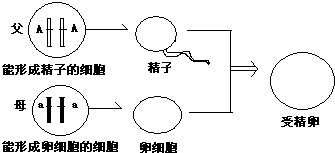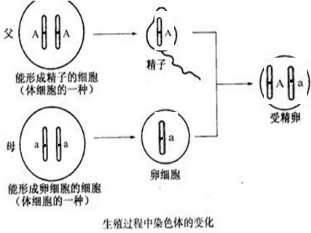如图是生物生殖过程中染色体变化示意图,据图回答:

(1)请画出图中精子、卵细胞、受精卵细胞中染色体和基因;
(2)若图为人类生殖过程中染色体变化的示意图,图中所示的是一对性染色体,父方体细胞中性染色体组成为XY,则产生的精子有两种,分别为含______和含______性染色体,母方体细胞中的性染色体组成为______,产生的卵细胞中只含______性染色体;
(3)从生殖细胞结合形成受精卵的角度看,决定生男生女的关键是由______生殖细胞所决定;从理论上讲,男女比例大致是______.
(1)在亲代的生殖细胞形成过程中,经过减数分裂,成对的染色体和基因分开,分别进入两个生殖细胞中.父亲产生的精子中含有一条具有基因A的染色体,母亲产生的卵细胞中含有一条具有具有a的染色体;受精卵中的染色体一条来自父方,一条来自母方,这样受精卵中的染色体数又恢复到亲代体细胞中的染色体数,保证了亲子代间遗传物质的稳定性.因此受精卵中含有父方提供的一条染色体和母方提供的一条染色体,基因组成是Aa.
(2)男性的性染色体为XY,女性的性染色体为XX.在亲代的生殖细胞形成过程中,经过减数分裂,两条性染色体彼此分离,男性产生两种类型的精子--含X染色体的精子和含Y染色体的精子.女性则只产一种含X染色体的卵细胞.受精时,如果是含X的精子与卵子结合,就产生具有XX的受精卵并发育成女性;如果是含Y的精子与卵子结合,就产生具有XY的受精卵并发育成为男性.
(3)从生殖细胞结合形成受精卵的角度看,受精时,精子和卵细胞的结合是随机的,可见后代的性别是由父(男)方产生的生殖细胞(精子)类型所决定的.由于男性可产生数量相等的X精子与Y精子,加之它们与卵子结合的机会相等,所以每次生男生女的概率是相等的.在整个人群中男女性别之比大致1:1.
故答案为:(1) ;
;
(2)X;Y;XX;X
(3)精子;1:1.
